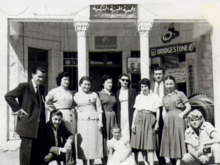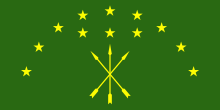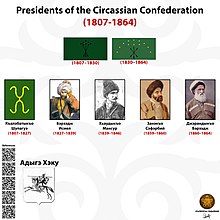
Back قومية شركسية Arabic Nationalisme circassien French Nacionalismo circasiano Galician Çerkes milliyetçiliği Turkish Черкеський націоналізм Ukrainian



| Part of a series on the |
| Circassians Адыгэхэр |
|---|
 List of notable Circassians Circassian genocide |
| Circassian diaspora |
| Circassian tribes |
|
Surviving Destroyed or barely existing |
| Religion |
|
Religion in Circassia |
| Languages and dialects |
|
| History |
|
Show |
| Culture |

Circassian nationalism[1][2][a] is the desire among Circassians worldwide to preserve their genes, heritage and culture,[3][4][5] save their language from extinction,[2][6][7] raise awareness about the Circassian genocide,[8][9][10] return to Circassia[11][12][13][14] and establish a completely autonomous or independent Circassian state in its pre-Russian invasion borders.[13][14][15]
In almost every community of Circassians around the world, a local advisory council called the "Adyghe Khase" can be found.[16] The goal of such councils are to provide Circassians with a comfortable place where they can speak Circassian, engage in Circassian cultural activities, learn about the laws of Adyghe Xabze or seek advice. These advisory councils are coordinated on a local and regional basis, and communicate internationally through the International Circassian Association (ICA).[17]
- ^ Fatima Tlisova. "Support for Circassian Nationalism Grows in the North Caucasus". Georgiandaily.net, through Adyga NatPress. [permanent dead link]
- ^ a b "Çerkes milliyetçiliği nedir?". Ajans Kafkas (in Turkish). 15 March 2011. Retrieved 17 February 2021.
- ^ Paul Golbe. Window on Eurasia: Circassians Caught Between Two Globalizing "Mill Stones", Russian Commentator Says. On Windows on Eurasia, January 2013.
- ^ Авраам Шмулевич. Хабзэ против Ислама. Промежуточный манифест.
- ^ Kalaycı, İrfan. "Tarih, Kültür ve İktisat Açısından Çerkesya (Çerkesler)". Avrasya Etüdleri.
- ^ "Biz Kimiz?". TADNET. 29 December 2019. Archived from the original on 17 May 2021.
- ^ "'Çerkes Milliyetçiliği' Entegre (Kapsayıcı) Bir İdeolojidir". www.ozgurcerkes.com (in Turkish). Retrieved 17 February 2021.
- ^ "152 yıldır dinmeyen acı". www.aa.com.tr. Retrieved 17 February 2021.
- ^ "Kayseri Haberi: Çerkeslerden anma yürüyüşü". Sözcü. Retrieved 17 February 2021.
- ^ "Çerkes Forumu, Çerkes Soykırımını yıl dönümünde kınadı". Milli Gazete (in Turkish). Retrieved 21 May 2021.
- ^ "Suriyeli Çerkesler, Anavatanları Çerkesya'ya Dönmek İstiyor". Haberler.com (in Turkish). 5 September 2013. Retrieved 17 February 2021.
- ^ "Dönüş" (in Turkish). KAFFED. Archived from the original on 28 September 2021. Retrieved 17 February 2021.
- ^ a b "Evimi Çok Özledim" (in Turkish). KAFFED. Archived from the original on 8 December 2021. Retrieved 17 February 2021.
- ^ a b Cite error: The named reference
Besleneywas invoked but never defined (see the help page). - ^ Özalp, Ayşegül Parlayan. "Savbaş Ve Sürgün, Kafdağı'nın Direnişi | Atlas" (in Turkish). Retrieved 17 February 2021.
- ^ Jonty, Yamisha. Circassians United
- ^ Jonty, Yamisha. Profile of the Diaspora: A Global Community
Cite error: There are <ref group=lower-alpha> tags or {{efn}} templates on this page, but the references will not show without a {{reflist|group=lower-alpha}} template or {{notelist}} template (see the help page).
© MMXXIII Rich X Search. We shall prevail. All rights reserved. Rich X Search